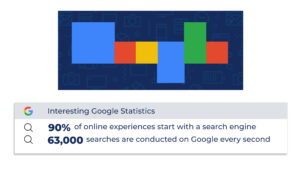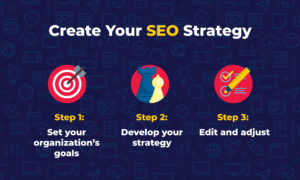With limited resources available, non-profits and small businesses have to put their marketing efforts into areas that will get results. Search engine optimization or ‘SEO’ is one of the best investments an organization can make to drive website traffic and build a brand profile.
When set up correctly, and with regular investments of time, SEO strategies will continue to pay off over the long term.

What is SEO?
SEO is the It is the practice of driving traffic to a website through organic (free) search results from search engines.
Search engines crawl and index all accessible content across the web then organize and rank search results based on what it thinks will provide users with the best possible answer to their search query.
The higher the score your content receives from a search engine results in a position closer to the top of on a search return page – which can have a huge impact on traffic.
 * Source
* Source
Position on a search return can be the difference between a user clicking on your link or that of a competitor. An SEO strategy is vital for a non-profit or small business to survive and thrive.
Understanding SEO
SEO is focused on strategies that make your information more attractive to search engines so that it gets ranked higher when a user searches a relevant keyword or phrase.
To be good at SEO, you need to understand intent: what answers are users searching for and how you can connect them to the products or services that you offer.
You also want to consider the objective of Google or any search engine is to provide an exceptional user experience by delivering the best possible search results. The more your content delights visitors, the more links you’ll gain which will, in turn, drive your value up and you’ll appear earlier in search engine return pages (SERPs.)
Since about 92% of searches are done through Google, we’ll focus their platform in the details below. Other search engines will employ a similar approach, so this information is applicable everywhere.
How to get started
When you’re just getting started, it can be easy to feel overwhelmed by SEO. According to Google, they use about 200 different factors to determine what search results to show.
As a beginner, you’re probably not going to have the time to address all 200 SEO ranking factors – here are the three most critical ranking considerations:
- Quality: Garbage content packed with keywords and tags will not offer significant value. Unfortunately, when it comes to quality content, there are no shortcuts. Start working on strategy, develop writers in your organization and get started today
- The freshness of content: Posting more frequently improves Google rankings but updating exisiting content on your website will also signal ‘freshness’ to Google’s algorithm
- Keywords: Consider what you can offer to site visitors and work backwards to develop keyword search terms. Then try to include those keywords in your content. Make sure it’s organic, add it to the title or into the copy but don’t include too many mentions, or Google may think you’re a spammer and score you accordingly.

1.Set your goals
What is the specific goal of your website? Is it to inform visitors, engage them, drive online sales…all of the above? You need to establish this first before you decide on your success measures of key performance indicators (KPIs.)
KPIs can be anything measurable that your organization wants to achieve through its website. Often non-profits and small businesses will use:
- Sales/donations
- Email sign-ups
- Contact form submissions
- Downloads (articles, whitepapers, etc.)
You’ll note that the KPIs listed above are not focused on SEO specific goals like ranking position or other performance metrics. Focus on what you want to achieve and tailor your SEO strategy to support those goals – do not start with SEO first and decide on goals after.
Once you’ve established your KPIs, you can begin to develop your SEO strategy.
2. Develop your strategy
Keyword research
To truly make the most of your SEO efforts, you need to understand what users are searching for and what they want from the content on your website.
Now if you’ve done any research on SEO you’ve probably seen a lot of talk about keywords. It’s important to note that keyword usage in the past was about putting the right term in the right place for search engines to find – not anymore.
Today, search engines are much more sophisticated, they look at meaning and user intent to get to the core of what a user is searching for – not exactly what they typed into the search engine.
Focus your efforts on topics, not just specific terms you want to cram into your content.
An excellent place to start is creating a keyword map, a list of all search keywords/phrases that are relevant to your website content. When creating this map, you’ll want to consider the following filters:
- Relevancy: Choose keywords relevant to your organization, including your mission, programs/services you offer and products. Need some help? Some tools can provide suggestions like Gooogle’s and Moz’s Keyword Explorer, but there are many others out there that can help you get started.
- Competition: Use the tools listed above to get a sense of competition for your keywords. The best approach is to go for keywords or phrases that are relevant to your content and aren’t hyper-competitive
Once you’ve created your keyword map of all the terms and phrases that are relevant to your organization’s work, you’ll want to make connections to those terms and existing content on your website. Take note of the gaps – where you don’t have content to support an identified keyword/phrase.
You’ll see how you can fill those gaps in the next section
Create high-quality content
Once you’ve established your goals and created your keyword map, you can move on to the most valuable SEO component – content.

Good content is well-written, free of spelling/grammatical errors, has reputable sources and is fact-checked.
To produce quality content, it takes time and effort. Here’s a quick checklist of questions to ask yourself when creating content for your organization.
- Does it answer a need? Give users what they are looking for if there’s no interest in a topic why spend time and effort on it. Know where there’s interest in your programs/products (based on your keyword research) and write about
- Is the language clear? Many non-profits are guilty of using industry jargon – remember, you’re writing for your target audience, not your peers so keep it simple
- Does it offer a good UX? A good user experience (UX) translates into longer time spent on your site and better SEO results. Optimize your page layout, so the text is scannable, break up paragraphs, highlight sub-sections – make it easy for users to digest your content
- Is it optimized for length? Longer content (1000+ words) currently ranks better in SEO, likely because it is more comprehensive. Consider longer pieces vs short ones – keeping value in mind
- Does it use the keywords? Don’t try to cram keywords into your content, use them naturally along with variants in titles (H1 tags), sub-sections and alt-text for images
- Did you include a call to action: Part of a good content strategy is having a user journey mapped out. Know where you want to send visitors after they read your content, another article? An email sign up? Make a donation or purchase? Always have a plan for what’s next.
- Is it technically optimized? Some technical components will help your search rankings, including:
- Page load speed
- Mobile optimization
- Optimized URL (short, descriptive URLs not numbers or code)
- All pages are unique (avoid duplicate content)
- Add alt-text to describe images (Google won’t automatically identify context)
3. Edit and Adjust: SEO isn’t static
Lastly, it’s important to remember that the variables that impact SEO are constantly changing. Don’t expect wild swings in how sites are ranked, rather minor tweaks that can be leveraged to further enhance your ranking. Use your data and the tools available to up your SEO game and reach your digital goals.
Want more help to drive traffic to your organization’s website? Contact us today.